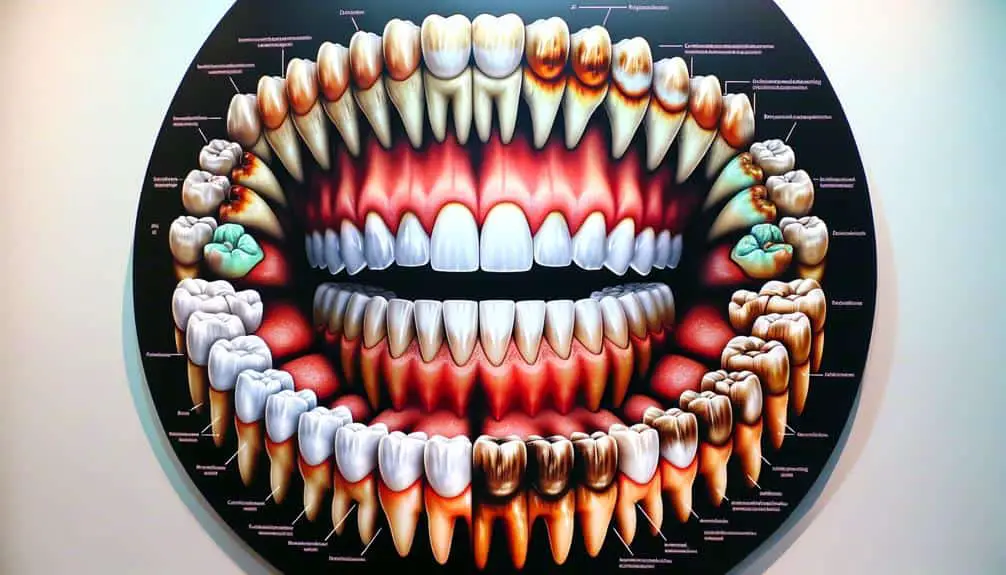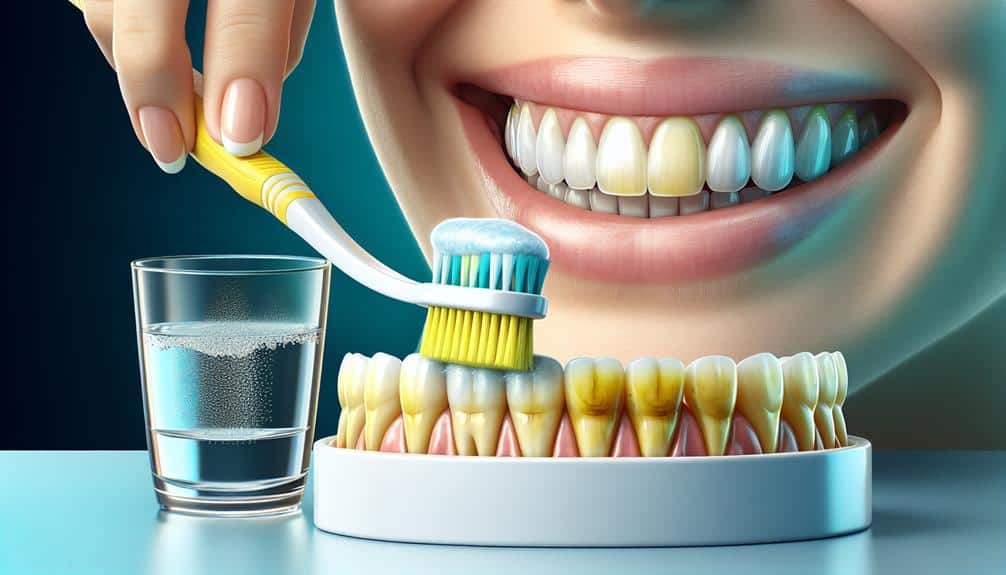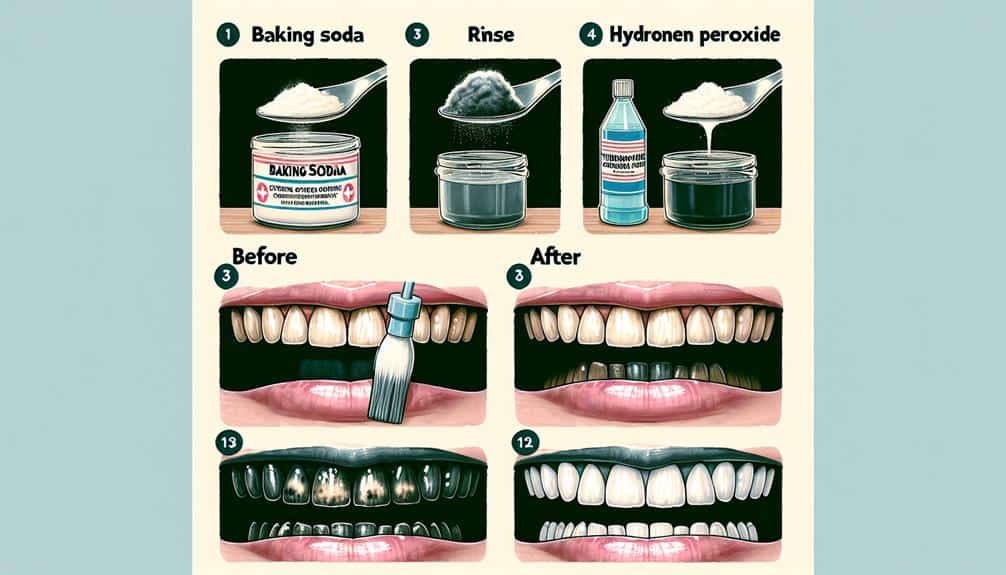To address tetracycline staining effectively, assess the severity by understanding the classifications based on color intensity. Opt for professional whitening treatments like bleaching or veneers recommended by dentists. Try home remedies such as baking soda paste or diluted hydrogen peroxide mouthwash. Prior to whitening, consult a dentist to evaluate underlying causes and determine the best approach. For stubborn stains, consider combining cosmetic dentistry treatments like professional whitening, microabrasion, porcelain veneers, or composite bonding. These methods can provide best results in treating tetracycline stains. Explore further for a thorough overview of stain removal options.
Key Points
- Professional whitening treatments offer effective stain reduction.
- Consider combining different cosmetic dentistry options for stubborn stains.
- Microabrasion can eliminate deep-seated tetracycline stains.
- Porcelain veneers provide a long-lasting solution for severe discoloration.
- Consult with a dentist to assess staining severity and choose appropriate treatments.
Assessing Tetracycline Staining Severity
To effectively evaluate the severity of tetracycline staining, begin by gauging the extent of discoloration on the affected surfaces. Staining classification is important in determining the depth and intensity of the stains. Class I stains are mild, appearing light yellow or orange, while Class II stains are moderate, presenting as darker shades of yellow or brown. Class III stains are severe, characterized by dark grey or dark brown discoloration. Understanding these classifications aids in developing an appropriate treatment plan.
Treatment planning for tetracycline staining involves considering various factors such as the patient's oral health, aesthetic goals, and the extent of the stains. For Class I stains, conservative approaches like professional whitening may be effective. Class II stains may require a combination of whitening treatments and possibly veneers or bonding for the best results. Class III stains often necessitate more advanced treatments like veneers or crowns to achieve satisfactory outcomes. By accurately classifying the stains and meticulously planning the treatment approach, clinicians can provide patients with tailored solutions for tetracycline staining.
Professional Whitening Options for Tetracycline Stains
Consider incorporating professional whitening as an effective treatment option for addressing tetracycline stains of varying severity levels. In-office treatments such as bleaching can greatly lighten these stubborn stains. Dentists specializing in cosmetic dentistry may also recommend veneers as a more permanent solution for severe tetracycline discoloration.
Professional whitening procedures conducted in the dental office utilize stronger whitening agents compared to over-the-counter products, providing more effective results. During these sessions, protective measures are in place to minimize potential side effects and guarantee the safety of the treatment.
Bleaching treatments administered by dental professionals can target deep-set tetracycline stains, offering a customized approach based on the individual's needs. Veneers, on the other hand, involve placing thin shells over the teeth to conceal severe discoloration permanently. While professional whitening may require multiple sessions for the best results, the outcome can be transformative, restoring confidence and enhancing the appearance of teeth affected by tetracycline staining.
Home Remedies for Tetracycline Stain Removal
For individuals seeking to address tetracycline stains at home, exploring natural remedies can be a cost-effective and accessible option. Here are some DIY solutions that may help in removing tetracycline stains:
- Baking Soda Paste: Create a paste using baking soda and water, then gently brush your teeth with it to help reduce stains.
- Hydrogen Peroxide Rinse: Dilute hydrogen peroxide with water and use it as a mouthwash to potentially lighten stains over time.
- Oil Pulling: Swish coconut oil in your mouth for about 15-20 minutes daily; some believe this may help reduce staining.
- Apple Cider Vinegar: Use apple cider vinegar as a mouthwash in moderation; its acidic nature could aid in removing stains.
- Activated Charcoal: Brushing with activated charcoal powder may help absorb stains and brighten your teeth.
While these natural remedies are popular, approaching them with caution and not expect immediate results. Consistency and patience are key when trying home remedies for tetracycline stain removal.
Considerations Before Whitening Tetracycline-Stained Teeth
Before proceeding with whitening procedures for tetracycline-stained teeth, evaluate the underlying causes of discoloration to determine the most appropriate treatment approach. Pre-whitening precautions are essential to guarantee the safety and effectiveness of the whitening process. Tetracycline stains are notoriously stubborn and may require a thorough approach for successful removal. Cosmetic dentistry options such as professional whitening treatments, veneers, or crowns can greatly improve the appearance of tetracycline-stained teeth.
It is vital to consult with a qualified dentist before initiating any whitening procedures. Dentists can assess the severity of the staining, identify any underlying dental issues, and recommend the most suitable treatment plan. In some cases, whitening treatments alone may not be sufficient to address tetracycline stains, and combining different cosmetic dentistry options could yield better results.
Understanding the nature of tetracycline stains and incorporating pre-whitening precautions are crucial steps in achieving excellent outcomes when whitening tetracycline-stained teeth. By carefully considering these factors, individuals can make informed decisions about the most suitable treatment approach for their specific needs.
Combining Treatments for Stubborn Tetracycline Stains
To effectively address stubborn tetracycline stains, a combination of different cosmetic dentistry treatments may be necessary for best results. When facing challenging cases of tetracycline staining, employing dual treatment approaches and advanced stain removal techniques can greatly enhance the outcome.
Here are some key strategies to explore:
- Professional Whitening: Professional whitening treatments can help lighten tetracycline stains effectively.
- Microabrasion: This technique involves removing a thin layer of enamel to eliminate deep-seated stains.
- Porcelain Veneers: Veneers can cover tetracycline stains, providing a long-lasting solution for a bright smile.
- Composite Bonding: Bonding can be used to mask tetracycline stains on individual teeth.
- Laser Therapy: Laser technology can aid in precise and targeted stain removal, improving overall results.
Frequently Asked Questions
Can Tetracycline Staining Be Prevented in the First Place?
To prevent tetracycline staining, focus on early intervention. Regular dental cleanings, avoiding tetracycline during teeth development, and using alternative antibiotics can be effective. Success in prevention methods hinges on awareness and timely action.
How Long Does It Typically Take to See Results From Professional Whitening Treatments for Tetracycline Stains?
How long does it take to see results from professional whitening treatments for tetracycline stains? Professional treatments typically show results within a few sessions, offering quicker and more effective outcomes compared to DIY options available.
Are There Any Potential Side Effects or Risks Associated With Home Remedies for Tetracycline Stain Removal?
When considering home remedies for tetracycline stain removal, it's important to be aware of potential risks. While some remedies may show efficacy, treatment combinations could lead to adverse effects. Consult a professional for guidance.
Is It Possible to Completely Remove Tetracycline Stains With Whitening Treatments, or Are They Only Able to Lighten the Stains?
You can't eradicate the past, but whitening treatments can work wonders. They tackle stains, but stain penetration affects complete removal. Consider treatment efficacy for realistic outcomes. Trust the process; a brighter smile awaits.
Are There Any Long-Term Consequences or Considerations to Keep in Mind When Combining Multiple Treatments for Stubborn Tetracycline Stains?
Consider potential long-term effects when combining treatments for stubborn tetracycline stains. Treatment combinations may impact tooth sensitivity, enamel erosion, or gum irritation. Consult with a dental professional to guarantee the safety and efficacy of such approaches.



